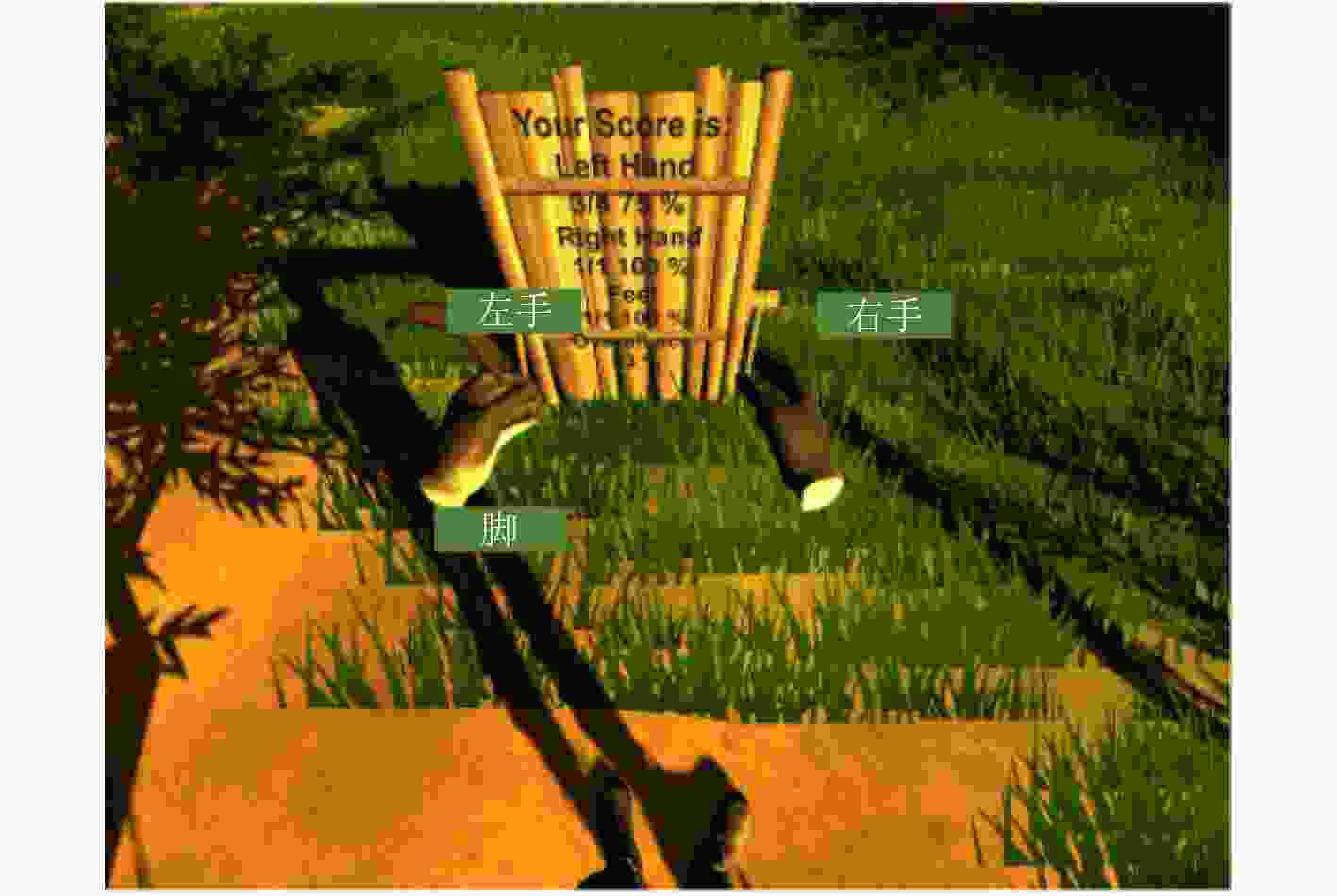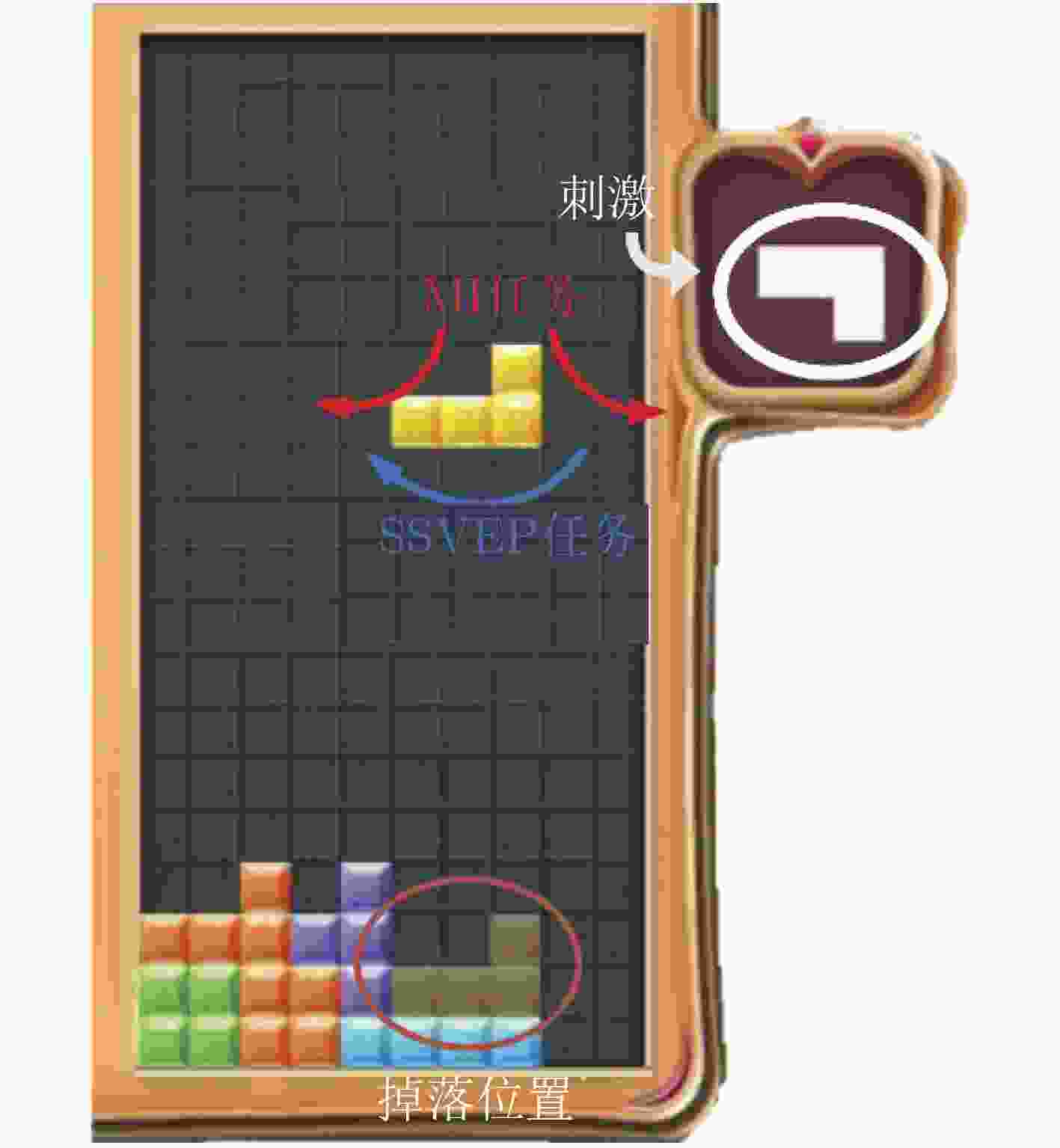| [1] |
WOLPAW J R, DEL R, MILLÁN J, and RAMSEY N F. Brain-computer interfaces: Definitions and principles[J]. Handbook of Clinical Neurology, 2020, 168: 15–23. doi: 10.1016/B978-0-444-63934-9.00002-0
|
| [2] |
WOLPAW J R, BIRBAUMER N, HEETDERKS W J, et al. Brain-computer interface technology: A review of the first international meeting[J]. IEEE Transactions on Rehabilitation Engineering, 2000, 8(2): 164–173. doi: 10.1109/tre.2000.847807
|
| [3] |
CATTAN G. The use of brain-computer interfaces in games is not ready for the general public[J]. Frontiers in Computer Science, 2021, 3: 628773. doi: 10.3389/fcomp.2021.628773
|
| [4] |
CATTAN G, ANDREEV A, and VISINONI E. Recommendations for integrating a P300-based brain–computer interface in virtual reality environments for gaming: An update[J]. Computers, 2020, 9(4): 92. doi: 10.3390/computers9040092
|
| [5] |
MERCADO J, ESCOBEDO L, and TENTORI M. A BCI video game using neurofeedback improves the attention of children with autism[J]. Journal on Multimodal User Interfaces, 2021, 15(3): 273–281. doi: 10.1007/s12193-020-00339-7
|
| [6] |
PARK K, KIHL T, PARK S, et al. Fairy tale directed game-based training system for children with ADHD using BCI and motion sensing technologies[J]. Behaviour & Information Technology, 2019, 38(6): 564–577. doi: 10.1080/0144929X.2018.1544276
|
| [7] |
SEKHAVAT Y A. Battle of minds: A new interaction approach in BCI games through competitive reinforcement[J]. Multimedia Tools and Applications, 2020, 79(5): 3449–3464. doi: 10.1007/s11042-019-07963-w
|
| [8] |
CHEN Yuliang. Design of a game control system based on Brain-computer interface: Link to a game[C]. Proceedings of the 2021 2nd International Conference on Computing and Data Science, Stanford, USA, 2021: 255–258.
|
| [9] |
TORRES E P, TORRES E A, HERNÁNDEZ-ÁLVAREZ M, et al. EEG-based BCI emotion recognition: A survey[J]. Sensors, 2020, 20(18): 5083. doi: 10.3390/s20185083
|
| [10] |
DE CASTRO-CROS M, SEBASTIAN-ROMAGOSA M, RODRÍGUEZ-SERRANO J, et al. Effects of gamification in BCI functional rehabilitation[J]. Frontiers in Neuroscience, 2020, 14: 882. doi: 10.3389/fnins.2020.00882
|
| [11] |
SINGH A K, WANG Yukai, KING J T, et al. Extended interaction with a BCI video game changes resting-state brain activity[J]. IEEE Transactions on Cognitive and Developmental Systems, 2020, 12(4): 809–823. doi: 10.1109/TCDS.2020.2985102
|
| [12] |
ARPAIA P, ESPOSITO A, MANCINO F, et al. Active and passive brain-computer interfaces integrated with extended reality for applications in health 4.0[C]. Proceedings of the 8th International Conference on Augmented Reality, Virtual Reality and Computer Graphics, Virtual Event, 2021: 392–405.
|
| [13] |
CHMURA J, ROSING J, COLLAZOS S, et al. Classification of movement and inhibition using a hybrid BCI[J]. Frontiers in Neurorobotics, 2017, 11: 38. doi: 10.3389/fnbot.2017.00038
|
| [14] |
WEN Dong, LIANG Bingbing, ZHOU Yanhong, et al. The current research of combining multi-modal brain-computer interfaces with virtual reality[J]. IEEE Journal of Biomedical and Health Informatics, 2020, 25(9): 3278–3287. doi: 10.1109/JBHI.2020.3047836
|
| [15] |
NAYAK T, KO L W, JUNG T P, et al. Target classification in a novel SSVEP-RSVP based BCI gaming system[C]. Proceedings of 2019 IEEE International Conference on Systems, Man and Cybernetics, Bari, Italy, 2019: 4194–4198.
|
| [16] |
MENG Jiayuan, XU Minpeng, WANG Kun, et al. Separable EEG features induced by timing prediction for active brain-computer interfaces[J]. Sensors, 2020, 20(12): 3588. doi: 10.3390/s20123588
|
| [17] |
TEZZA D, CAPRIO D, GARCIA S, et al. Brain-controlled drone racing game: A qualitative analysis[C]. Proceedings of the 2nd International Conference on Human-Computer Interaction, Copenhagen, Denmark, 2020: 350–360.
|
| [18] |
COYLE D, GARCIA J, SATTI A R, et al. EEG-based continuous control of a game using a 3 channel motor imagery BCI: BCI game[C]. Proceedings of 2011 IEEE Symposium on Computational Intelligence, Cognitive Algorithms, Mind, and Brain, Paris, France, 2011: 1–7.
|
| [19] |
KARÁCSONY T, HANSEN J P, IVERSEN H K, et al. Brain computer interface for neuro-rehabilitation with deep learning classification and virtual reality feedback[C]. Proceedings of the 10th Augmented Human International Conference 2019, Reims, France, 2019: 22.
|
| [20] |
VOURVOPOULOS A, FERREIRA A, and BADIA S B I. NeuRow: An immersive VR environment for motor-imagery training with the use of brain-computer interfaces and vibrotactile feedback[C]. Proceedings of the 3rd International Conference on Physiological Computing Systems, Lisbon, Portugal, 2016: 43–53.
|
| [21] |
PUTRI F, DING Hao, GARCIA A, et al. Towards successful multi-user Brain-Computer Interface (BCI) gaming: Analysis of the EEG signatures and connectivity[C]. Proceedings of the 3rd International Conference on Computer-Human Interaction Research and Applications, Vienna, Austria, 2019: 59–65.
|
| [22] |
LI Junhua, LIU Ye, LU Zhen, et al. A competitive brain computer interface: Multi-person car racing system[C]. Proceedings of the 2013 35th Annual International Conference of the IEEE Engineering in Medicine and Biology Society, Osaka, Japan, 2013: 2200–2203.
|
| [23] |
KUMAR M K, PARAMESHACHARI B D, PRABU S, et al. Comparative analysis to identify efficient technique for interfacing BCI system[J]. IOP Conference Series:Materials Science and Engineering, 2020, 925: 012062. doi: 10.1088/1757-899X/925/1/012062
|
| [24] |
FILIZ E and ARSLAN R B. Design and implementation of steady state visual evoked potential based brain computer interface video game[C]. Proceedings of the 2020 IEEE 20th Mediterranean Electrotechnical Conference, Palermo, Italy, 2020: 335–338.
|
| [25] |
VIDAL J J. Real-time detection of brain events in EEG[J]. Proceedings of the IEEE, 1977, 65(5): 633–641. doi: 10.1109/PROC.1977.10542
|
| [26] |
PARAFITA R, PIRES G, NUNES U, et al. A spacecraft game controlled with a brain-computer interface using SSVEP with phase tagging[C]. Proceedings of the 2013 IEEE 2nd International Conference on Serious Games and Applications for Health, Vilamoura, Portugal, 2013: 1–6.
|
| [27] |
PEREZ-VALERO E, LOPEZ-GORDO M A, and VAQUERO-BLASCO M A. An attention-driven videogame based on steady-state motion visual evoked potentials[J]. Expert Systems, 2021, 38(4): e12682. doi: 10.1111/exsy.12682
|
| [28] |
CRUZ I, MOREIRA C, POEL M, et al. Kessel run-a cooperative multiplayer SSVEP BCI game[C]. Proceedings of the 9th International Conference on Intelligent Technologies for Interactive Entertainment, Funchal, Portugal, 2017: 77–95.
|
| [29] |
FARWELL L A and DONCHIN E. Talking off the top of your head: Toward a mental prosthesis utilizing event-related brain potentials[J]. Electroencephalography and Clinical Neurophysiology, 1988, 70(6): 510–523. doi: 10.1016/0013-4694(88)90149-6
|
| [30] |
FINKE A, LENHARDT A, and RITTER H. The MindGame: A P300-based brain–computer interface game[J]. Neural Networks, 2009, 22(9): 1329–1333. doi: 10.1016/j.neunet.2009.07.003
|
| [31] |
LI Man, LI Feng, PAN Jiahui, et al. The MindGomoku: An online P300 BCI game based on bayesian deep learning[J]. Sensors, 2021, 21(5): 1613. doi: 10.3390/s21051613
|
| [32] |
BAYLISS J D and BALLARD D H. Single trial P3 epoch recognition in a virtual environment[J]. Neurocomputing, 2000, 32/33: 637–642. doi: 10.1016/S0925-2312(00)00226-5
|
| [33] |
HUANG Zhihua, ZHENG Wenming, WU Yingjie, et al. Ensemble or pool: A comprehensive study on transfer learning for c-VEP BCI during interpersonal interaction[J]. Journal of Neuroscience Methods, 2020, 343: 108855. doi: 10.1016/j.jneumeth.2020.108855
|
| [34] |
PENG Faqiang and HUANG Zhihua. A c-VEP BCI system for psychological experiments[C]. Proceedings of the 2019 12th International Congress on Image and Signal Processing, BioMedical Engineering and Informatics, Suzhou, China, 2019: 1–5.
|
| [35] |
BEVERIDGE R, WILSON S, CALLAGHAN M, et al. Neurogaming with motion-onset visual evoked potentials (mVEPs): Adults versus teenagers[J]. IEEE Transactions on Neural Systems and Rehabilitation Engineering, 2019, 27(4): 572–581. doi: 10.1109/TNSRE.2019.2904260
|
| [36] |
RIECHMANN H, FINKE A, and RITTER H. Using a cVEP-based brain-computer interface to control a virtual agent[J]. IEEE Transactions on Neural Systems and Rehabilitation Engineering, 2016, 24(6): 692–699. doi: 10.1109/TNSRE.2015.2490621
|
| [37] |
FRIEDRICH E V C, SUTTIE N, SIVANATHAN A, et al. Brain–computer interface game applications for combined neurofeedback and biofeedback treatment for children on the autism spectrum[J]. Frontiers in Neuroengineering, 2014, 7: 21. doi: 10.3389/fneng.2014.00021
|
| [38] |
MUÑOZ J E, LOPEZ D S, LOPEZ J F, et al. Design and creation of a BCI videogame to train sustained attention in children with ADHD[C]. Proceedings of the 2015 10th Computing Colombian Conference, Bogota, Colombia, 2015: 194–199.
|
| [39] |
HRAMOV A E, MAKSIMENKO V A, and PISARCHIK A N. Physical principles of brain-computer interfaces and their applications for rehabilitation, robotics and control of human brain states[J]. Physics Reports, 2021, 918: 1–133. doi: 10.1016/j.physrep.2021.03.002
|
| [40] |
LI Zina, ZHANG Shuqing, and PAN Jiahui. Advances in hybrid brain-computer interfaces: Principles, design, and applications[J]. Computational Intelligence and Neuroscience, 2019, 2019: 3807670. doi: 10.1155/2019/3807670
|
| [41] |
KONEČNÝ R and LIAROKAPIS F. Foresthlon: Investigating gender experience through a hybrid BCI game[C]. Proceedings of the 3rd International Conference on Human-Computer Interaction, Virtual Event, 2021: 57–74.
|
| [42] |
XU Minpeng, HAN Jin, WANG Yijun, et al. Implementing over 100 command codes for a high-speed hybrid brain-computer interface using concurrent P300 and SSVEP features[J]. IEEE Transactions on Biomedical Engineering, 2020, 67(11): 3073–3082. doi: 10.1109/TBME.2020.2975614
|
| [43] |
WANG Zhihua, YU Yang, XU Ming, et al. Towards a hybrid BCI gaming paradigm based on motor imagery and SSVEP[J]. International Journal of Human–Computer Interaction, 2019, 35(3): 197–205. doi: 10.1080/10447318.2018.1445068
|
| [44] |
MÜHL C, GÜRKÖK H, BOS D P O, et al. Bacteria hunt: Evaluating multi-paradigm BCI interaction[J]. Journal on Multimodal User Interfaces, 2010, 4(1): 11–25. doi: 10.1007/s12193-010-0046-0
|
| [45] |
KHONG A, LIN Jiangnan, THOMAS K P, et al. BCI based multi-player 3-D game control using EEG for enhancing attention and memory[C]. Proceedings of 2014 IEEE International Conference on Systems, Man, and Cybernetics, San Diego, USA, 2014: 1847–1852.
|
| [46] |
KINNEY-LANG E, MURJI S, KELLY D, et al. Designing a flexible tool for rapid implementation of brain-computer interfaces (BCI) in game development[C]. Proceedings of the 2020 42nd Annual International Conference of the IEEE Engineering in Medicine & Biology Society, Montreal, Canada, 2020: 6078–6081.
|
| [47] |
SERRANO-BARROSO A, SIUGZDAITE R, GUERRERO-CUBERO J, et al. Detecting attention levels in ADHD children with a video game and the measurement of brain activity with a single-channel BCI headset[J]. Sensors, 2021, 21(9): 3221. doi: 10.3390/s21093221
|
| [48] |
ARRAMBIDE K, FREIMAN CORMIER L, WEHBE R R, et al. The development of "orbit": The collaborative BCI game for children with AD(H)D[C]. Proceedings of Extended Abstracts of the Annual Symposium on Computer-Human Interaction in Play Companion Extended Abstracts, Barcelona, Spain, 2019: 341–348.
|
| [49] |
MRIDHA M F, DAS S C, KABIR M M, et al. Brain-computer interface: Advancement and challenges[J]. Sensors, 2021, 21(17): 5746. doi: 10.3390/s21175746
|
| [50] |
SUBRAMANIAN R R, VARMA K Y, BALAJI K, et al. Multiplayer online car racing with BCI In VR[C]. Proceedings of the 2021 5th International Conference on Intelligent Computing and Control Systems, Madurai, India, 2021: 1835–1839.
|
| [51] |
SCOTT J A and SIMS M. Acceleration of therapeutic use of brain computer interfaces by development for gaming[C]. Proceedings of the 12th International Conference on Intelligent Technologies for Interactive Entertainment. Virtual Event, 2020: 267–281.
|
| [52] |
ZHANG Rongxiang. Virtual reality games based on brain computer interface[C]. Proceedings of 2020 International Conference on Intelligent Computing and Human-Computer Interaction, Sanya, China, 2020: 227–230.
|
| [53] |
XU Lichao, XU Minpeng, KE Yufeng, et al. Cross-dataset variability problem in EEG decoding with deep learning[J]. Frontiers in Human Neuroscience, 2020, 14: 103. doi: 10.3389/fnhum.2020.00103
|
| [54] |
XU Minpeng, XIAO Xiaolin, WANG Yijun, et al. A brain–computer interface based on miniature-event-related potentials induced by very small lateral visual stimuli[J]. IEEE Transactions on Biomedical Engineering, 2018, 65(5): 1166–1175. doi: 10.1109/TBME.2018.2799661
|






 下载:
下载:






 下载:
下载:
